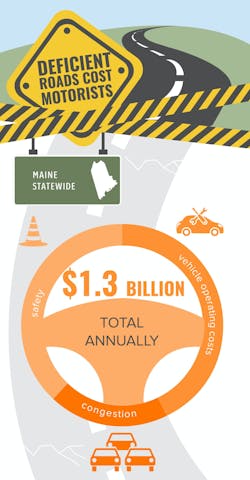TRIP Says Maine Motorists Lose $1.3 Billion on Bad Roads
Roads and bridges that are deteriorated, congested or lack some desirable safety features cost Maine motorists a total of $1.3 billion statewide annually–as much as $1,561 per driver in some urban areas–due to higher vehicle operating costs, traffic crashes, and congestion-related delays.
Increased investment in transportation improvements at the local, state and federal levels could relieve traffic congestion, improve road, bridge and transit conditions, boost safety, and support long-term economic growth in Maine, according to a new report released today by TRIP, a Washington, DC-based national transportation research nonprofit.
The TRIP report, “Maine Transportation by the Numbers: Meeting the State’s Need for Safe, Smooth and Efficient Mobility,” finds that throughout Maine, 44 percent of major locally and state-maintained roads are in poor or mediocre condition, 13 percent of locally and state-maintained bridges (20 feet or more in length) are rated poor/structurally deficient, and 783 people lost their lives on the state’s roads from 2015-2019. Maine’s major urban roads are becoming increasingly congested, causing significant delays and choking commuting and commerce.
Driving on deficient roads in Maine costs the state’s drivers a total of $1.3 billion per year in the form of extra vehicle operating costs (VOC) as a result of driving on roads in need of repair, lost time and fuel due to congestion-related delays, and the costs of traffic crashes in which the lack of adequate roadway features likely were a contributing factor. The report includes regional pavement and bridge conditions, a list of the most congested corridors, highway safety data, and cost breakdowns for the Bangor, Lewiston-Auburn, and Portland urban areas and statewide.
The TRIP report finds that 23 percent of major locally and state-maintained roads in Maine are in poor condition and another 21 percent are in mediocre condition, costing the state’s drivers an additional $563 million each year in extra vehicle operating costs, including accelerated vehicle depreciation, additional repair costs, and increased fuel consumption and tire wear. The remaining 14 percent of Maine’s major roads are in fair condition and 42 percent are in mediocre condition.
“Transportation is fundamental to our safety, economic prosperity, and quality of life,” said Maine Department of Transportation commissioner Bruce Van Note. “The challenges we face due to our chronic funding shortfall have been made worse by the recent drops in travel due to Covid-19 and the resulting reductions in Highway Fund and other transportation-related revenues. Once we have defeated the virus and dealt with the resulting economic fallout, we must work to resolve our structural transportation revenue problems so that we can not only maintain our transportation system, but also improve it with targeted capacity improvements, improvements to villages and downtowns, and measures to address climate change. Investing in transportation is key to moving Maine forward.”
Thirteen percent of Maine’s bridges are rated in poor/structurally deficient condition, the sixth highest rate in the nation. Bridges that are rated poor/structurally deficient have significant deterioration of the bridge deck, supports or other major components. Fifty-five percent of the state’s bridges are rated in fair condition and the remaining 32 percent are in good condition.
Traffic congestion in the state is worsening, causing as much 28 annual hours of delay for the average motorist and costing up to $568 annually per driver in lost time and wasted fuel. Statewide, drivers lose $250 million annually as a result of lost time and wasted fuel due to traffic congestion. The TRIP report identifies and ranks the 20 most congested corridors in Maine based on an analysis of delays during typical morning and evening peak travel periods.
